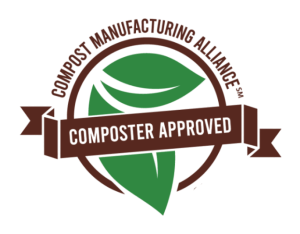CMA has the privilege, and the responsibility, to certify compostable products to standards that protect compost manufacturing and, in turn, our environment. While there are some areas where the best we can do is to mitigate harm, there are other, more advanced areas of the market in whichwe feel that holding products to the highest standards is the responsible choice.
Industrial compost manufacturers have historically accepted some paper-based products such as napkins and food soiled paper. In keeping with this reality, CMA accepts some paper-based products that have not been tested to ASTM standards. For example, paper products with <1% of a single additive and a minimum of 95% fiber are eligible for substrate acceptance (SA). These products are “accepted” but not approved or certified by CMA. Until feasible and economical alternatives are readily available, we continue to work with manufacturers to move these products forward to full approval and certification.
For product certification, CMA requires passing ASTM D6400 or D6868 laboratory standards, as well as other requirements including field disintegration testing and total fluorine testing. For certification,CMA has made a conscious choice to interpret these standards conservativelyin the interest of protecting compost feedstocks and the environment through reducing and eventually eliminating non-compostable additives and materials that microfragment rather than fully biodegrade. Thisis also taken with a view toward risk management for our customers and our composting partners.
CMA evaluates all multi-layered products under ASTM D6868; this includes thermoplastic and thermoset coated (e.g., acrylic coated) paper. We require biodegradation testing of all coatings and layers, regardless of percentage. We understand that there are differences in opinion about whether this is necessary. However, ASTM D6868 6.3.1 requires, “The plastic coating or polymeric additives must meet the requirements of subsection 6.3 of Specification D6400.”ASTM D6400 6.3 requires, “6.3 Biodegradation—A plastic product must demonstrate a satisfactory rate of biodegradation by achieving the following ratio of conversion to carbon dioxide found in 6.3.1 and 6.3.1.1 within 180 days using the latest revision of Test Method D5338, ISO 14855–1, or ISO 14855–2.” ASTM D5338 is preferred because it uses finished compost as the test medium.
Read together, D6868 6.3.1 requires a coating or additive to show “a satisfactory rate of biodegradation by achieving the following ratio of conversion to carbon dioxide…” ASTM D6868 6.3.1 points only to D6400 6.3. D6400 6.3 only references 6.3.1 and 6.3.1.1 to specify the ratio of conversion to carbon dioxide. ASTM D6400’s reference to 6.3.1 and 6.3.1.1 is for a limited purpose and does not incorporate those sections in their entirety. Therefore, CMA requires that all coatings and layers be tested under ASTM D6868 to show biodegradation separately, in addition to the disintegration requirements for the whole product.
This is not just interpretational nitpicking. CMA believes this is the right direction to address the growing issue of microplastics in our environment. As a consumer society, we have inundated ourselves with a material that, while providing great social benefit, has also left us with persistent material that pollutes our water, soil and air. The long-term effects on human health, animal and plant life, water and soilare of great concern and are largely unknown. Human health is potentially impacted through toxicity, bioaccumulation, inflammatory and immune responses, and microbiome effects that can result in the spread of pathogens. [1]
Woods End Laboratories and Eco-Cycle[2], in a study of plastics in composting, demonstrated that: 1) plastic coatings do not biodegrade; 2) plastic coatings retard the biodegradation of paper layers; and 3) microplastic fragments were shed from all plastic-coated samples, contaminating the finished compost.
When microplastics are released into the environment, there is no feasible remediation measure. Compost manufacturers have changed their acceptance standards over time, but they are inundated with contamination, much of it in the form of plastics. While coatings on packaging may seem de minimis compared to all other sources of plastic contamination, pleading “I am not as bad as they are” is not an approach that will lead to improving the problem.
For these reasons, CMA continues to require biodegradation of all coatings on all certified products. Similarly, CMA will not adopt ASTM D8410 for evaluation of cellulosic-fiber-based packaging. While D8410 does exclude thermoplastic coatings, it does not necessarily exclude thermoset materials. As such, if a thermoset coating is applied at <1% dry weight, it would be exempt from biodegradation testing under this standard.The net result is that products can meet the 90% biodegradation requirement where traditional plastic coatings are used, resulting in knowing introduction of microplastics into the compost stream. For this reason, CMA will not accept D8410 for evaluation of fiber-based packaging.
On the other hand, CMA does fully support, approve and certify industrially compostable bioplastics that do fully biodegrade in the lab and disintegrate in its field testing. These materials are not viewed as an issue for industrial composting. The acceptance of products produced from these CMA certified products is up to each individual industrial composting operation and their regulators.
CMA encourages all stakeholders to strive for the best we can do.CMA recognizes the investments and innovation demonstrated by the packaging industry and compost manufacturers to address these issues. We understand sustainability is challenging and striving for solutions is sometimes daunting. We are committed to continuing our work with composters and packaging companies to connect the system in a way that achieves true sustainability. Sustainability is a team sport. We are grateful to have you on our team.
[1] S. L. Wright and F. J. Kelly, “Plastic and human health: A micro issue?,” Environmental Science & Technology, vol. 51, no. 12, pp. 6634–6647, 2017.
[2]W. Brinton, C. Dietz, A. Bouyounan, D. Matsch, “Microplastics in Compost: The Environmental Hazards Inherent in the Composting of Plastic-Coated Paper Products, Woods End Laboratories and Eco-Cycle, Originally Published April 2011. Updated April 2016 and May 2018.
